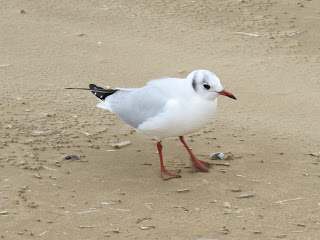 |
| Titchwell |
The forecast for today was suppose to be dry but cloudy. When we arrived at Titchwell this morning, it was cold and windy. The weatherman was wrong as we left Norwich as it was raining. Fortunately, it had not reached Titchwell yet and we had only the wind and cold temperatures to worry about as we made our way down to the beach.
 |
| Wildfowl on the first pool |
 |
| Teal |
It was relatively quiet bird wise during our walk, probably thanks to the wind as most of the birds were hunkering down in the tidal pools and rarely in the air. The majority of these birds were wildfowl, mainly teals, wigeons, shovelers and mallards. Teals in particular were everywhere, feeding or sleeping together like a large covering of small brown-grey blobs on the mud and shallow water. The far side of the first main pool was full with large flocks of brent and greylag geese. The brents kept coming as more were flying in to join them and they were constantly streaming over our heads during our walk to and from the beach, barking their grunted calls as they went by.
 |
| Greylags |
 |
| Wigeon |
 |
| Brent Geese |

 |
| Teal drake |
 |
| Bird tracks in the mud |
 |
| Pintail |
Amongst the mass of wildfowl out on the first pool were several pintail drakes. Once you get your eye in, you could easily spot them with their white breasts and neck stripes out from the crowd from afar. But once you see them in detail using a scope, you soon realise what a handsome bird male pintails are. They have this chocolate brown head, grey and black body with a creamy-yellow patch on the wing and, of course, that long pointy tail which the species is named after. The females on the other hand, are less obvious being speckly brown all over.
 |
| Black-tailed Godwit and Teal |
Though the wildfowl dominate our surroundings, there were waders out with them, feeding from the mud. Avocets were swishing the surface of the pool with their upturned bill for any aquatic invertebrates they could find. Godwits and redshanks have to probe deep into the mud for their meals, which are mostly worms, crustations and molluscs, but are pretty entertaining to watch as they do this with their bills vanishing up to their nostrils. We also spot dunlin, lapwing and a greenshank as we made our way towards the beach.
 |
| Redshank |
 |
| Lapwing |
 |
| Greenshank |
 |
| Dunlin |
 |
| Sand blowing in the wind |
At the beach, the wind was blowing trails of sand to the direction of the sea. The sand grains were being blown into the air forming a mini sandstorm about ankle height from the ground and were like streaks of moving sand whipping across the beach everytime a gust blew. It was poetry in motion to watch. Mum had a bright idea, she wanted us to walk to the ruins in front of us for a better view of the sea to see what birds are about by the shore and over the waves. This turned out to be a bad idea as it meant the strong wind was blowing the sand directly at us and it pelted us.
 |
| Black-headed Gull |
A curious black-headed gull landed by our feet to check us out. It struggled in the wind and it went back up into the air, flying with difficulty and ended up hovering close to our faces before landing by our feet again. It seemed to like us and it followed us to the ruins were it was joined by a common gull (I think). There wasn't much about out at sea, but at least we made two new feathered friends so it wasn't a complete waste of time. On our way back, it started to rain and we got a bit wet. Never trust the weatherman!
 |
| Common Gull |



































It's funny I was just reading about Titchwell in the RSPB magazine this morning, and realised it has been years since I last visited, glad to see it is still offering such great birds.
ReplyDeleteIncidentally I get totally fed up of planning trips by the weather forecast, so often it is wrong.